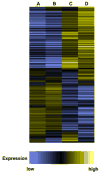The influence of human respiratory epithelia on Pseudomonas aeruginosa gene expression
- PMID: 17166692
- PMCID: PMC1934408
- DOI: 10.1016/j.micpath.2006.10.004
The influence of human respiratory epithelia on Pseudomonas aeruginosa gene expression
Abstract
The opportunistic pathogen Pseudomonas aeruginosa can cause acute or chronic infections in humans. Little is known about the initial adaptation of P. aeruginosa to host tissues and the factors that determine whether a P. aeruginosa-epithelial cell interaction will manifest as an acute or a chronic infection. To gain insights into the initial phases of P. aeruginosa infections and to identify P. aeruginosa genes regulated in response to respiratory epithelia, we exposed P. aeruginosa to cultured primary differentiated human airway epithelia. We used a P. aeruginosa strain that causes acute damage to the epithelia and a mutant with defects in Type III secretion and in rhamnolipid synthesis. The mutant did not cause rapid damage to epithelia as did the wildtype. We compared the transcriptomes of the P. aeruginosa wildtype and the mutant to each other and to P. aeruginosa grown under other conditions, and we discovered overlapping sets of differentially expressed genes in the wildtype and mutant exposed to epithelia. A recent study reported that exposure of P. aeruginosa to epithelia is characterized by a repression of the bacterial iron-responsive genes. These findings were suggestive of ample iron availability during infection. In contrast, we found that P. aeruginosa shows an iron-starvation response upon exposure to epithelial cells. This observation highlights the importance of the iron starvation response in both acute and chronic infections and suggests opportunities for therapy.
Figures



Similar articles
-
Pseudomonas aeruginosa flagellin and alginate elicit very distinct gene expression patterns in airway epithelial cells: implications for cystic fibrosis disease.J Immunol. 2004 Nov 1;173(9):5659-70. doi: 10.4049/jimmunol.173.9.5659. J Immunol. 2004. PMID: 15494517
-
The Small RNA ErsA Plays a Role in the Regulatory Network of Pseudomonas aeruginosa Pathogenicity in Airway Infections.mSphere. 2020 Oct 14;5(5):e00909-20. doi: 10.1128/mSphere.00909-20. mSphere. 2020. PMID: 33055260 Free PMC article.
-
Pseudomonas aeruginosa infection of airway epithelial cells modulates expression of Kruppel-like factors 2 and 6 via RsmA-mediated regulation of type III exoenzymes S and Y.Infect Immun. 2006 Oct;74(10):5893-902. doi: 10.1128/IAI.00489-06. Infect Immun. 2006. PMID: 16988269 Free PMC article.
-
[Molecular determinants in regulating Pseudomonas aeruginosa type III secretion system--a review].Wei Sheng Wu Xue Bao. 2008 Oct;48(10):1413-7. Wei Sheng Wu Xue Bao. 2008. PMID: 19160828 Review. Chinese.
-
The response of Pseudomonas aeruginosa to iron: genetics, biochemistry and virulence.Mol Microbiol. 1999 Nov;34(3):399-413. doi: 10.1046/j.1365-2958.1999.01586.x. Mol Microbiol. 1999. PMID: 10564483 Review.
Cited by
-
Inactivation of Chibby affects function of motile airway cilia.J Cell Biol. 2009 Apr 20;185(2):225-33. doi: 10.1083/jcb.200809144. Epub 2009 Apr 13. J Cell Biol. 2009. PMID: 19364920 Free PMC article.
-
Extracellular aminopeptidase regulates exopolysaccharide production of Pseudomonas aeruginosa via quorum sensing.ISME J. 2025 Jan 2;19(1):wraf038. doi: 10.1093/ismejo/wraf038. ISME J. 2025. PMID: 40037286 Free PMC article.
-
Novel experimental Pseudomonas aeruginosa lung infection model mimicking long-term host-pathogen interactions in cystic fibrosis.APMIS. 2009 Feb;117(2):95-107. doi: 10.1111/j.1600-0463.2008.00018.x. APMIS. 2009. PMID: 19239431 Free PMC article.
-
Pseudomonas aeruginosa Lifestyle: A Paradigm for Adaptation, Survival, and Persistence.Front Cell Infect Microbiol. 2017 Feb 15;7:39. doi: 10.3389/fcimb.2017.00039. eCollection 2017. Front Cell Infect Microbiol. 2017. PMID: 28261568 Free PMC article. Review.
-
PA3297 Counteracts Antimicrobial Effects of Azithromycin in Pseudomonas aeruginosa.Front Microbiol. 2016 Mar 16;7:317. doi: 10.3389/fmicb.2016.00317. eCollection 2016. Front Microbiol. 2016. PMID: 27014238 Free PMC article.
References
-
- Smith RS, Iglewski BH. P. aeruginosa quorum-sensing systems and virulence. Curr Opin Microbiol. 2003;6:56–60. - PubMed
-
- Finck-Barbancon V, Goranson J, Zhu L, Sawa T, Wiener-Kronish JP, Fleiszig SM, et al. ExoU expression by Pseudomonas aeruginosa correlates with acute cytotoxicity and epithelial injury. Mol Microbiol. 1997;25:547–57. - PubMed
-
- Lee EJ, Cowell BA, Evans DJ, Fleiszig SM. Contribution of ExsA-regulated factors to corneal infection by cytotoxic and invasive Pseudomonas aeruginosa in a murine scarification model. Invest Ophthalmol Vis Sci. 2003;44:3892–8. - PubMed
-
- Sawa T, Yahr TL, Ohara M, Kurahashi K, Gropper MA, Wiener-Kronish JP, et al. Active and passive immunization with the Pseudomonas V antigen protects against type III intoxication and lung injury. Nat Med. 1999;5:392–8. - PubMed
Publication types
MeSH terms
Substances
Grants and funding
LinkOut - more resources
Full Text Sources
Other Literature Sources
Molecular Biology Databases

